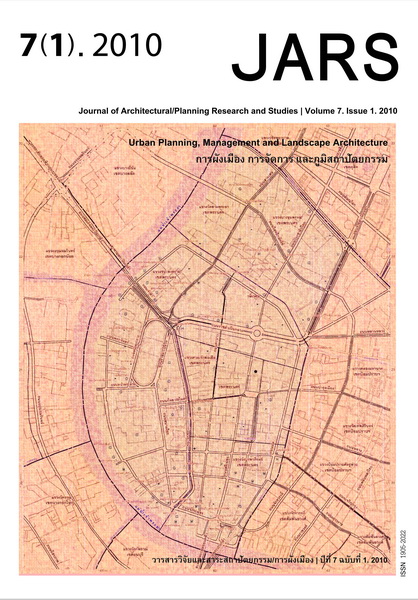Using the Kernel Density Estimation Surface for Criminal Pattern: A Case Study in Phranakhon District, Bangkok
Main Article Content
Abstract
Crime mapping devoted to detecting high-crime-density areas known as hot spots. The hot spot analysis
helps planners or police identify high-crime areas, types of crime being committed, and the best way to
respond. This paper discusses the hot spot analysis using the Kernel Density Estimation. The method used for
data analysis and displayed results included an application of the Geographic Information System (GIS) supplementary
to discussion. GIS technology can help analyze information, such as types of crime by location, victim
population groups served and underserved, and the location of victim service organizations and their
geographic service areas. This information can be used to examine the availability of basic services and the
sufficiency of services for specialized population groups. It can visually display multiple funding sources in a
geographic area to help in a fair distribution of resources. It can be extremely useful in developing strategic
program and financial plans for the maintenance and development of victim services.
Downloads
Article Details

This work is licensed under a Creative Commons Attribution-NonCommercial-NoDerivatives 4.0 International License.
All material is licensed under the terms of the Creative Commons Attribution 4.0 International (CC-BY-NC-ND 4.0) License, unless otherwise stated. As such, authors are free to share, copy, and redistribute the material in any medium or format. The authors must give appropriate credit, provide a link to the license, and indicate if changes were made. The authors may do so in any reasonable manner, but not in any way that suggests the licensor endorses you or your use. The authors may not use the material for commercial purposes. If the authors remix, transform, or build upon the material, they may not distribute the modified material, unless permission is obtained from JARS. Final, accepted versions of the paper may be posted on third party repositories, provided appropriate acknowledgement to the original source is clearly noted.
References
Breslin, P., Frunzi, N., Napoleon, E., & Ormsby, T. (1999). Getting to know ArcView GIS – The geographic information system (GIS) for everyone. Redlands, CA: ESRI Press,
Chainey, S., & Ratcliffe, J. (2005). GIS and crime mapping. West Sussex, England: John Wiley & Sons.
Duangurai, J. (1989). การศึกษาความสัมพันธ์ของสภาพแวดล้อมทางกายภาพกับการเกิดคดีอาชญากรรมกรณีศึกษา สถานตำรวจนครบาลบางซื่อ [The relationships between physical environment and crime in Bang-sue metropolitan police jurisdiction]. Master Thesis, Faculty of Architecture, Chulalongkorn University, Bangkok, Thailand.
Jiamchaisri, A. (2006). ขนาดและขอบเขตพื้นที่รับผิดชอบที่เหมาะสมของสถานีตำรวจนครบาล [Optimum responsible areas and boundaries for Bangkok metropolitan police station]. Master Thesis, Faculty of Architecture, Chulalongkorn University, Bangkok, Thailand.
Malczewski, J. (1999). GIS and multicriteria decision analysis. USA: John Wiley & Sons
Maurizio, G., Paul, L., & Phil, A. (2007). Kernel density estimation and percent volume contours in general practice catchment area analysis in urban areas. GISRUK 2007: Proceedings of the Geographical Information Science Research UK 15th Annual Conference. Maynooth, Ireland, 11th-13th April 2007.
Piamsomboon, P. (1981). การควบคุมอาชญากรรมจากสภาพแวดล้อม [Crime control through environmental design]. Bangkok, Thailand: Odeon Store.
Piamsomboon, P., & Sawangnetr, S. (1992). การวเคราะห์เส้นโยงด้วยลิสเรล: สถิติสำหรับนักวิจัยทางวิทยาศาสตร์สังคมและพฤติกรรม [Path analysis (Lisrel): Research methology in behavioral sciences and social sciences]. Bangkok, Thailand: National Institute of Development Administration.
Suwan, M. (1998). เทคนิคเชิงปริมาณสำหรับวิชาภูมิศาสตร์ [Quantitative techniques for geography]. Bangkok, Thailand: Odeon Store.


